
Felicia aethiopica is a low shrublet of up to about 50 cm high that is assigned to the family Asteraceae. It has rigid, leathery, inverted egg-shaped leaves, with only the lowest pair set oppositely. It has flower heads with an involucre of about 8 mm in diameter with bracts that each contain three resin ducts, and have one whorl of twelve to fourteen ray florets with about 11 mm long and 1½ mm wide blue straps surrounding many yellow disc florets. The plant is called wild aster or dwarf Felicia in English, and wilde-aster or bloublombossie in Afrikaans. Flowering occurs year-round. Wild aster can be found in the Western and Eastern Cape provinces of South Africa.

Polyarrhena is a genus of low, branching shrublets that is assigned to the daisy family. Its stems are alternately and densely set with entire or somewhat toothed leaves. Like in almost all Asteraceae, the individual flowers are 5-merous, small and clustered in typical heads, and which are surrounded by an involucre of in this case three whorls of bracts. In Polyarrhena, the centre of the head is taken by yellow disc florets, and is surrounded by one single whorl of white ligulate florets that have a pinkish-purple wash on the underside. These florets sit on a common base and are not individually subtended by a bract. The species occur in the Cape Floristic Region. Polyarrhena reflexa has long been cultivated as an ornamental and is often known under its synonym Aster reflexum.
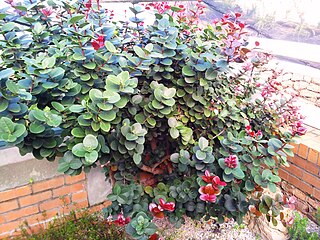
Maurocenia frangula is a small, rounded tree of about 4 metres, that is endemic to the Western Cape, South Africa.
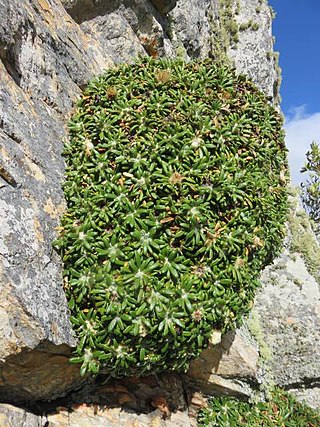
Oldenburgia paradoxa Less. is a species in the genus Oldenburgia, in the family Asteraceae.

Serruria elongata or long-stalk spiderhead is a plant belonging to the protea family. It is an erect, hairless shrublet of 1–1½ m (3½–5 ft) high with densely set, alternate, finely divided leaves lower down the plant, with needle-like segments. On top of an up to 30 cm (12 in) long inflorescence stalk are several, loosely arranged heads of pin-like, densely silvery-haired flower buds, each of which opens with four curled, magenta pink corolla lobes. The species is endemic to the southern Western Cape province of South Africa. It flowers during the southern hemisphere winter and early spring, between June and September.

Serruria fasciflora or common pin spiderhead is a species of flowering plant in the family Proteaceae. It is a sprawling to upright shrublet of 40 cm to 1 m high and about 1⁄2 m wide. It has finely divided, upward curving leaves with thread-thin segments and clusters of sweetly scented heads, each consisting of five to seven silvery pink flowers, that may be found year-round, but mostly from May to December. It is a rather widespread and common species, that is restricted to the south of the Western Cape province of South Africa.

Oedera capensis is a prickly shrublet belonging to the family Asteraceae. It has stems that branch only at the foot and are densely set over their entire length with narrowly triangular leathery leaves with a sharp tip at approximately right angles to the stem. At their tip are what at first sight appears to be a single flowerhead with yellow ray florets and yellow disc florets. In fact, these are mostly nine densely cropped heads, as is suggested by the nine domes of the "disc" of the composite head, the untidy arrangement of the ray florets, and becomes very clear when cutting through the composite head. It is an endemic of the south of the Western Cape province in South Africa.

Oedera squarrosa ("Vierkant-perdekaroo") is a prickly shrublet belonging to the family Asteraceae.
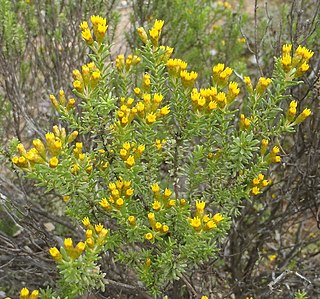
Oedera genistifolia is a prickly shrublet belonging to the family Asteraceae.
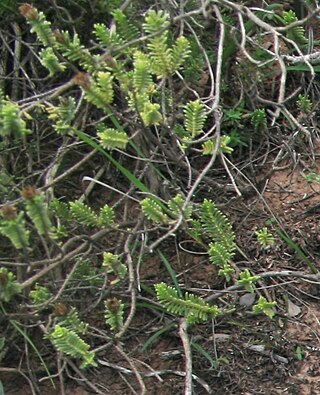
Oedera uniflora ("Kalksteenperdekaroo") is a prickly shrublet belonging to the family Asteraceae.
Relhania speciosa is a shrublet belonging to the daisy family, indigenous to the southern Cape, South Africa.
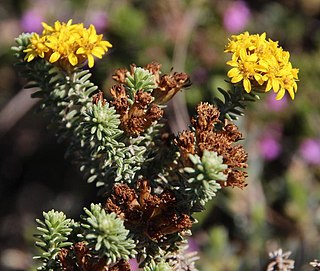
Relhania garnotii is a shrublet belonging to the daisy family, indigenous to the southern Overberg region of the Western Cape Province, South Africa.
Relhania calycina is a shrublet belonging to the daisy family. It is found in rocky Fynbos and Renosterveld vegetation, growing in rocky, loamy or sandy soil, in the Western Cape Province and Eastern Cape Province, South Africa.
Lobostemon collinus, the pyjamabush or iron healthbush, is a species belonging to the forget me not family. It is known only from the fynbos biome of the Western Cape of South Africa.

Serruria williamsii, commonly known as the king spiderhead, is a flower-bearing shrub that belongs to the genus Serruria and forms part of the fynbos. The plant is native to the Western Cape and only occurs in the Riviersonderend Mountains.
Selago thomii is a species of plant in the family Scrophulariaceae. It is endemic to the Western Cape, South Africa.
Diosma haelkraalensis, or Hagelkraal's diosma, is a rare species of plant from South Africa.
Athanasia pectinata is a species of plant from the Western Cape of South Africa.
Ursinia nudicaulis, also known as the longstalk paraseed or the little daisy is a species of plant from South Africa. It belongs to the daisy family.
Osteospermum burttianum is a species of plant from South Africa.












